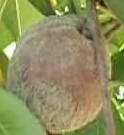 Brown rot is a common disease of stone fruits including peaches, nectarines, cherries, and plum. It may also affect almond and pome fruits such as apples and pears. It is usually caused by the fungus Monilinia fructicola and can cause damage to flowers, and twigs, as well as fruit, on or off the tree. Brown rot is especially significant in reducing crop yields when the climate is wet and warm.
Brown rot is a common disease of stone fruits including peaches, nectarines, cherries, and plum. It may also affect almond and pome fruits such as apples and pears. It is usually caused by the fungus Monilinia fructicola and can cause damage to flowers, and twigs, as well as fruit, on or off the tree. Brown rot is especially significant in reducing crop yields when the climate is wet and warm.
Description
Brown rot has two distinct phases. The first sign of the disease may be seen in early spring when flowers and twigs are infected. Spores of the fungus are carried by wind, rain and insect to flowers where they invade the reproductive parts of the flower and then the twig joining the flower to the tree. The flower dies and turns brown but remains attached to the tree. The dead twig becomes a canker. Masses of ash-gray-brown spores may form on the dead flowers and cankers if conditions are moist or humid.
The second phase of brown rot involves the fruit. As the fruit ripens the sugar content increases, and the fruits become more susceptible to brown rot infection. If the climatic conditions are moist and warm (60-70 degrees F), circular tan spots may appear on the fruit and develop masses of ash-gray-brown spores that can further infect other fruits. Infected fruit that is left on the tree may dry out and become a mummy that is a source of spores for future infection. Infected twigs and infected fruit that fall from the tree are also sources of spores for infection the following year.
Control
Good cultural practices are key to controlling brown rot. The first step is sighting the fruit trees in a placed with good air circulation to facilitate drying. The second step involves good sanitation practices: removing the diseased mummies, cankers, and twigs from both the tree and the ground under and around the tree. The use of fungicides involves several applications: one to three sprayings as the flowers open and two or three more two to three week before harvest.